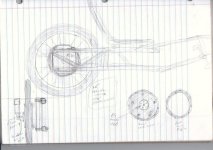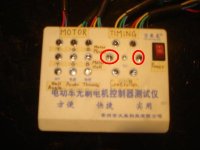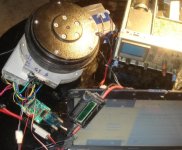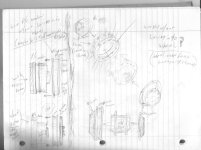Another sketch from lunchtimes:

Shown as mounted by the right side, I think I would actually mount by left side, so that I can bolt a freewheel-threaded hub flange to the right side, to be able to still have a "legal" bicycle, with the chain still attached to the wheel.
Also, if I use a pillow bearing on the right side I can add a short bolt or axle threaded into the center hole of the powerchair motor's rotor, to give support on the right side, so it doesn't have twisting forces from weight/load on the left side mounts.
To test on CrazyBike2, I would have to replace the present bottom rackmount strip cargo pod support with 1" square tubing, same as the top, to give a sturdier place to bolt the motor itself to. This is something I have planned to do just for stiffer cargo pod support anyway, but never gotten round to.
Right now the thing mainly keeping me from just going ahead and doing this is that my lathe is buried under a bunch of stuff int eh back room (which will take me at least a day or two to move, as I wont' have the energy to do it all at once), and I am not sure that the bed is large enough to hold the discs I have to make the adapter plate and ring from.
I might have to find someone else here on ES that could do it and trade them work or parts or something. I guess when I get to where I have time to try this whole thing out I can put up a want ad for that. Doesnt' need a lathe, even a 2D CNC could do it, if it can cut thin steel (1/8"?) or thick aluminum (1/4"?), as they are just flat plates.
I *might* be able to cut them out by hand, using a compass to scribe lines and then cut roughly with angle grinder, then file and sand until as close as I can get them, but I expect a fair bit of runout this way.
The rotor I can "lathe" by simply bolting the motor down flat and then bolting the lathe's toolholder down to the same table, or strapping the motor down to the lathe bed sideways, close to the toolholder, once I unbury the lathe itself.
Then I have to locate bolts (m7? m8? bigger?) that will fit the threads/holes on the rotor face for the outer holes, and then longer ones than presently there for the center of the rotor to secure the freewheel to it as well as the rotor to the axle inside. Also need cover bolts for the hub flange, as I know I don't have enough of those without taking them out of a working hubmotor. (M3? M4?)
Pretty sure I already have a bolt or axle the right size for the center hole, and I have a pillow bearing I can use that I got from (I think) mud2005, along with some other stuff (might've been someone else--veloman maybe?). (I usually label the boxes I keep stuff in so I knwo where ti came from, but I forgot to with a coupel of them and can't recall right now--would have to look thru my build threads to see if I noted it down there).
Getting the other stuff done to the bike to bea ble to put hte motor on is relatively trivial, I just have to do it in a way that doesn't preclude taking it right back off and putting the regular motor wheel back on--should be easy enough.








